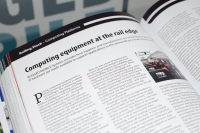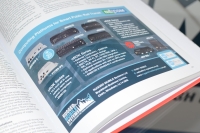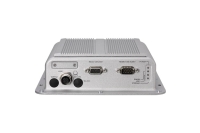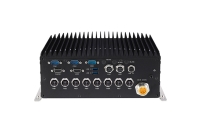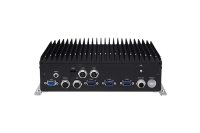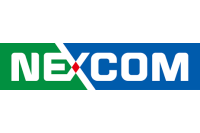Computing equipment at the rail edge
In the Rail Professional Industry Reference Book & Supply Chain Directory 2022 RUGGED MOBILE Systems consider how suppliers and manufacturers are ensuring that advances in IT hardware are made available to support applications in demanding on-train environments. Our discussion from pages 258 -259 of the Rail Today section of the Directory is presented below:
Placing computing equipment into a rail environment presents a number of challenges. The continuing rapid advances in computing, including Artificial Intelligence (AI) and advanced video and data analytics etc., are already delivering benefits to many areas of businesses and society. The rail industry is no exception in wishing to exploit these advances. However, the implementation of such technology in rail, and in particular to on-train environments, has its own set of requirements and challenges not seen in most traditional IT.
RUGGED MOBILE Systems has for the past twelve years been the UK value added partner and distributor for NEXCOM Inc – a world leader in the design and manufacture of mobile computing platforms. These platforms include an extensive range of solutions specifically developed and certified for use on rolling stock. This range is continually being extended to keep abreast of the latest technical advances in computer technology and ensuring that these advances are available for the benefit of on-train applications.
The Demand:
On-train computing solutions are required for a broad range of application areas including train security, safety and operational management; train telematics and asset monitoring; passenger information and entertainment; driver cab information support and train communication infrastructure etc. These applications encompass video recording and analytics solutions for passenger and luggage security, seat occupancy, Covid-19 mask wearing compliance, people counting, door clearance, and include the adoption of AI based analytics for scene analysis and facial recognition etc. In addition, train forward facing applications with video and LIDAR analytics for monitoring signal light adherence, detecting track obstructions, flooding alert, vegetation ingress assessments, and even rail-side and bridge damage detection. There is also potential for providing platform approach surveillance, with on-train cab display and alerting of platform incident etc., prior to the train arriving at the platform, and similar solutions for crossing incident warning direct to the train.
There are also a host of requirements for more advanced telematics and asset monitoring to improve the reliability and maintainability of the rolling stock. These range from real time pantograph and overhead power line monitoring using video analytics to sensor based monitoring of the drive train, breaking and doors functions etc. Enhanced passenger information with real-time updating of Passenger Information Displays and messaging boards, with access to additional real-time information and status of on-going connections across the rail network and beyond. Passengers also have an expectation to see seamless usage of internet access and streaming while on their journey – either via their own personal devices or seat back display systems. The ability of the train operator to support additional passenger services, such as train hosted video streaming, without needing to access the wider internet off the train, is now a reality.
Support is also available for rail operators for enhancing on-train ticket verification and issuing, and on-train retail operations. Also, other systems can provide support to achieve optimal staffing of trains. These applications create increased demand for secure on-train communications, with high performance mobile access hubs, providing Wi-Fi access and multiple 4G/LTE and 5G communications channels to the internet/the cloud while on the move. The hubs also need to support high throughput on-train networks, including up to 10G Ethernet (copper and fibre SFP+ networks) and multiple Power-over-Ethernet (PoE) connections to PoE camera’s, PoE displays, intelligent antenna and sensors etc
The on-train challenge:
The computing platforms to support such on-train applications are required to meet the strict criteria for EMC (electro-magnetic compatibility), operating temperature ranges, shock, vibration, and power input performance that the rail industry has defined for any electronic equipment installed on rolling stock. Manufacturers are required to independently certify that the equipment they supply meet Rail Standards, including the general standard EN-50155, fire safety standard EN-45545-2, plus other rail power standards. To complicate things further, a wide range of supply voltages are used on rolling stock, with standards including 24, 48, 72, 96 and 110VDC. System PSU’s also need to continue to deliver output during power interruptions of up to 10ms etc.
The train environment has a number of additional constraints not usually seen elsewhere. There are physical constraints, with limited cabinet space, resulting in equipment sharing enclosures with other electronic and electrical equipment, placing restrictions on the size of systems that can be deployed. This can also impact the operating temperature range of equipment. High data communications rates cannot be guarantee from the moving train to the internet, or to other off train rail systems. As a result, many systems are optimised for most processing to be carried out at the edge, and not returned centrally for processing. This is especially so with camera based solutions, where data storage and analytics, including AI processing, is carried out locally on the train. In addition, systems are usually expected to run unattended, with no local terminal, and often need remote system management support. Specifiers often prefer systems that are fanless and be verified to an IP sealing standard for dust and water ingress – for improved reliability. There is also an expectation that the systems will have high longevity and availability of supply.
The solutions:
NEXCOM Inc has a long and strong track record for manufacturing a wide range of high-quality systems that meet the requirement for most of the application areas mentioned above and maintain strict compliance with the rolling stock regulations and standards. These include compact entry level nROK1020-A and VTC 1910-IPK systems with low power intel Atom cpu’s, for general purpose use.
The nROK 622x Series systems utilizing the latest Intel Atom x7-3950 and nROK1031 with Elkhart Lake cpu’s, providing configuration flexibility for cost effective wireless gateway, video surveillance, analytics, storage and communications solutions. The nROK7251 and nROK7252 Series provide access to powerful Intel 9th Generation Intel i7 and Xeon cpu’s, with up to 64GB RAM and user accessible storage bays to meet large data storage requirements. They can support up to eight PoE ports, are ‘5G ready’ and can optionally support up to four LTE/5G modules with eight externally accessible SIM cards to maximise connectivity and throughput.
Additional options booster AI accelerator modules from Intel and NVIDIA are also available. The nROK75x Series support the full range of power input standards, and also have options for wide range 24VDC through 110VDC PSUs, so identical systems can be used across fleets with differing power supply standards. The above nROK systems all have -40oC to +70oC (OT4) operating temperature ranges,and some are be sealed to IP65 or IP67. The latest NEXCOM vROK3030 10.4- inch all-in-one railway open frame panel computer, is designed for human machine interface (HMI) and passenger information system applications. It implements the latest Intel Atom® x6414RE processor for both Windows and Linux platforms. It is able to support analog camera x 4 or PoE camera x 2 (Optional) for security purpose. The LCD panel 1,200nits guarantees sunlight readability and the open frame provides mounting flexibility.
AI at the railway edge:
The NEXCOM AI edge accelerator aROK range is specifically for rail artificial intelligence applications, employing artificial neural networks, machine vision and machine learning. Delivering ‘Inference At The Edge’ is NEXCOM’s goal to help developers to deal with mass computational intensive processes efficiently and accurately and avoid the need to do it centrally in the cloud. The aROK 5510 19-inch 2U Rackmount AI Intelligent Railway Computer supports high powered NVIDIA AI GPU’s modules closely coupled with Intel i7 9th Generation and Xeon cpu’s and provides up to 128GB RAM.
It also supports a high speed NVMe drive plus six externally accessible drive bays, giving up to 24TB of on-train storage, plus options for four PoE ports and Dual 10G LAN (Fibre SFP+) and multiple expansion ports for up to four LTE/5G modems (with again eight SIM slot) and WLAN modems. The aROK 8110 Scalable Expansion AI Intelligent Railway Computer has similar GPU and cpu performance to the aROK 5510 but has an alternative form factor, and supports more PCIe modules, including three PCIe X4 slots and one PCIe X16slot. Optional PCIe modules are available, each supporting four channel PoE ports, giving total of 12 PoE. With this wealth of rail focussed computing products and experience, along-side a proven configuration and customisation service, RUGGED MOBILE Systems and NEXCOM are ideal partners for any on-train computing project.
For more information, please get in touch on T. 01691 900222 or email us on [email protected].

